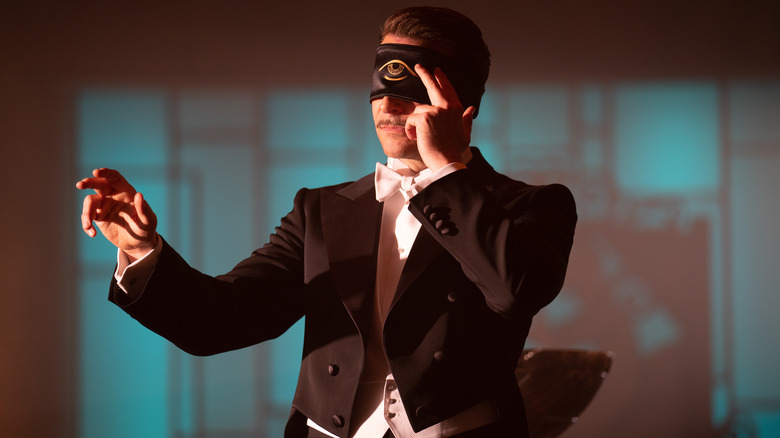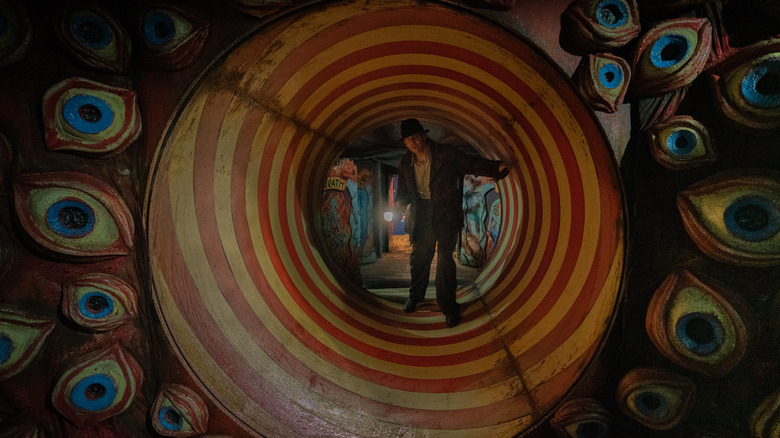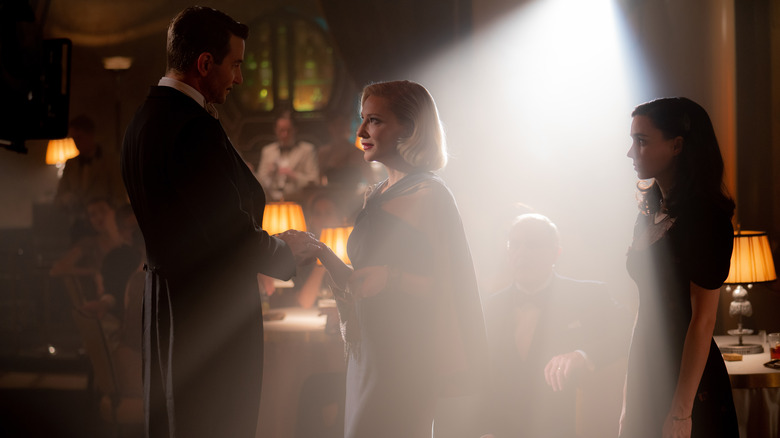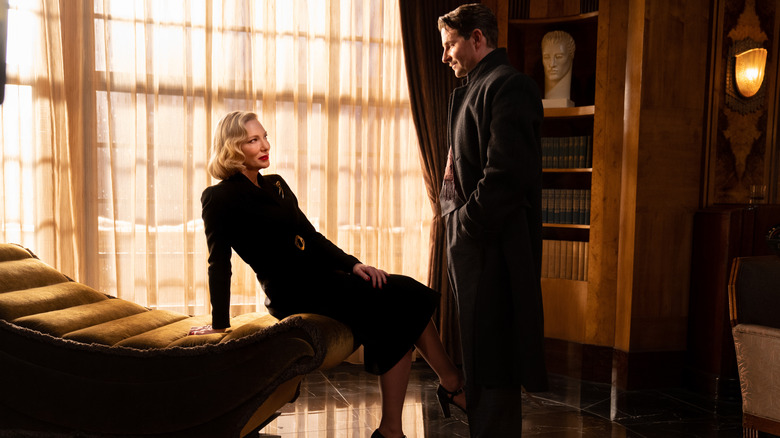
Stan Carlisle walks away from a house on fire and ends up at a carnival. This is how Guillermo del Toro's gorgeous noir "Nightmare Alley" begins, setting the mood for a wickedly enjoyable tale of freak shows, dark and stormy nights, innocent dames, morally bankrupt schemers, and a femme fatale to die for. Adapted from the 1946 novel by William Lindsay Gresham and the delectably dark 1947 film adaptation starring Tyrone Power, del Toro's "Nightmare Alley" is a carnival funhouse of earthly horrors.
The filmmaker usually dabbles in the supernatural and has a fondness for monsters. But there's nothing otherworldly here, and all the monsters are human. The '47 movie is a bit nastier; a bit meaner. Perhaps del Toro is too much of a dreamer and a lover of darkness to recreate such acidity. That doesn't make his "Nightmare Alley" any less thrilling.
Working with co-writer Kim Morgan, del Toro has conjured up a hauntingly beautiful world where Ferris Wheels glow brightly against dark skies full of bolts of lightning. Where pickled specimens of dead things float in jars full of formaldehyde. Where it seems to always be cloudy. Where snow drifts down through perfectly framed windows. Where every room is choked with art deco baubles. Where a cigarette is perched in the corner of everyone's mouth. Where everyone seems slightly damned.
No Spook Shows

Bradley Cooper is Stan Carlisle, a mysterious loner who spends the first 13 or so minutes of the movie completely silent, even when people are directly talking to him. Who is this man from nowhere? He lands a job helping out at a carnival, starting with manual labor and then working his way up to being part of an act. He works as an assistant to Zeena (Toni Collette), a "clairvoyant" who plays the carnival crowd for suckers. But Zeena and her husband Pete (David Strathairn) have morals. While they're technically bilking the audience, they don't let things get too far. Specifically, they like to avoid "spook shows" -- that is, convincing the crowd that they can talk to dead loved ones. When this happens at one point, Zeena actually goes so far as to take a person aside and tell them the truth -- that it's all an act, that there are no ghosts hovering about.
Stan doesn't get that. As far as he's concerned, the con should go on. He tries to couch this belief by saying that such spook shows will give people hope, but Zeena and Pete, old hands at this, won't hear of it. Pete has seen better days. He used to be a big part of Zeena's act, but he's hit the bottle so hard that he can barely stand up. Strathairn, one of those great character actors who can do so much with so little, turns the character into a sympathetic loser; a guy spiraling down the drain.
During his time at the carnival, Stan also befriends Molly (Rooney Mara), a sweet, innocent gal who pretends to be electrocuted every night with some Tesla coils. Molly seems naive to the extreme, and Stan claims he loves her. Maybe he does. Maybe he doesn't. You can never tell with Stan. Cooper does great work here, constantly playing his Tarot cards close to the vest, never letting the audience into his mind. Is he no good? Is he just a flawed guy trying to get by? It's hard to say, and that's part of the fun.
A Femme Fatale To Die For

Two years later, Stan and Molly have left the carnival behind. Taking what he learned from Zeena and Pete, Stan has a clairvoyant act of his own, and it's not relegated to seedy carnivals, either. Instead, he performs in tie and tails for a crowd of rich folks at a swanky club. And he's a hit, too! Using Molly as his assistant, Stan fools the crowd into thinking he has mind-reading abilities, and the crowd eats it up, diligently gasping and clapping at just the right moments.
But there's someone in the crowd one night who sees through Stan's rouse. This is psychiatrist Dr. Lilith Ritter, and she's the main attraction here. As good as the first half of "Nightmare Alley" may be, it really comes to life when Lilith shows up, played by Cate Blanchett. Blanchett was born to be a femme fatale in a film noir, and del Toro knows it. Dan Laustsen lights her in a consistently alluring way -- there are multiple shots where the top half of her head, including her eyes, are bathed in shadows, and those shadows follow her around as if she had control over them. And from that darkness, those eyes sparkle with menace. Blanchett, with her deliberate way of speaking and the seductive way she breathes cigarette smoke, is simultaneously hot as hell and icy cold, and everything she does here is dynamite. She's pretty poison in an ornate bottle.
Stan sees something of a kindred spirit in Lilith, and he seeks her out. Soon, the two have worked out a little scheme in which Stan is introduced to some of Lilith's wealthy patients, and, using Lilith's confidential knowledge, is able to trick them into paying him huge sums of cash for a reading. Molly is wary of this, especially when Stan starts embracing the spook show life, telling people he can contact their dead loved ones. One such person is obscenely wealthy figure Ezra Grindle (Richard Jenkins), who wants to communicate with someone he lost a long time ago. Lilith warns Stan that Ezra is "dangerous," but he's not worried. He can take care of himself. Right?
Take A Trip Down Nightmare Alley

As sumptuous as all of this is, "Nightmare Alley" does suffer from problems of pacing. Blanchett's introduction to the film is so fierce that when the film starts focusing on anyone other than her, the story starts to feel like it's dragging. Stan's con game with Ezra goes on a little too long (although it's worth noting it goes on even longer in the book), and del Toro and Morgan's script fails to make this section of the story particularly interesting. At least not at first. However, "Nightmare Alley" does manage to eventually right itself, heading into a climax bursting with brutal violence and shocking twists. More than that, it's all building up towards an ending that burns its way into your very soul. Without giving anything away, let me just tell you the final shot of this movie is an all-timer, and even if the film as a whole doesn't work for you, I'm confident you'll walk out of the theater haunted by those last moments.
Del Toro remains a master of his craft, and it should be no surprise that the "Nightmare Alley" production design is impeccable. Every single frame of this thing looks simultaneously gorgeous and ominous. The very vibe of the film itself is downright eerie. And while Blanchett is the knock-out, del Toro peppers his cast with great character actors who all manage to make an impression, no matter how small their parts. Willem Dafoe is a hoot as the no-nonsense carnival owner; Holt McCallany is imposing as Ezra's muscle; and Collette, always great, makes the most of a small part, bringing a weariness to the role of someone who has seen it all. Only Mara seems slightly out of place here, primarily because her character feels undercooked -- she's simply the sweet, innocent kid who gets mixed up in a bad world. A little more character-building here would've gone a long way.
None of this is enough to really harm "Nightmare Alley," which is yet another winner from del Toro, a director who loves the weird, the strange, the wicked, the perverse. Del Toro is perhaps a touch too romantic for this kind of pitch-black material, but it's impossible not to get swept up in the thrills and chills of "Nightmare Alley."
/Film Rating: 8 out of 10
Read this next: The Best Movies Of 2021 So Far
The post Nightmare Alley Review: Guillermo del Toro's Carnival Noir Is Stylish as Hell, With a Standout Cate Blanchett Performance appeared first on /Film.
0 Comments